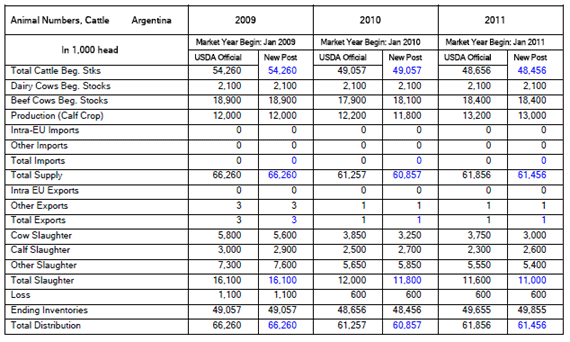



Argentina Livestock and Products Semi-annual Report 2011
Argentine beef exports for 2011 are now estimated at 270,000 tons, 30,000 tons lower than the official USDA estimate, according to teh USDA Foreign Agricultural Service. The main reasons for the drop are high local cattle and beef prices, significantly limited beef production, and the government’s limitations on exports, prioritizing the supply to the domestic market.Commodities:
Beef and Cattle
Production:
Argentine beef production for 2011 is now projected at 2.5 million tons, carcass weight equivalent (cwe), slightly lower than the official USDA estimate. The main reasons behind this drop are: 1) an expected shorter slaughter, now at 11.0 million head, reflecting official data of the last few months of 2010 and January 2011. High feeder cattle prices are encouraging breeders to rebuild depleted herds and to add more weight to each animal, thus selling fewer cattle, but heavier; 2) cattle finishers are taking more advantage of the good conditions of the pastures, gaining kilos at lower cost. As a result of fewer feeder cattle available, finishers also prefer to add additional weight to their cattle; 3) feedlots are going through a difficult situation due to the unusually wide negative price differential between fed cattle prices and feeder cattle prices. Feed prices have lately increased further and the government is no longer providing subsidies. Many feedlots are owed large sums of money from the government’s subsidy program implemented in early 2007 and later suspended in April 2010. Contacts estimate that the number of cattle in feedlots in 2011 will drop significantly. Private estimates indicate that in January 2011 the unused capacity was close to 50 percent.
Consumption:
Consumption is expected to drop marginally from our previous forecast as smaller beef output will not be fully offset by a small decline in exports.
Trade:
Post’s new 2011 export projection is 270,000 tons, cwe, 10 percent lower than the USDA official forecast. This is the lowest level since 2001 when Argentina suffered a major foot and mouth disease outbreak. Local contacts are providing a wide range of estimations, which range from 250-300,000 tons, cwe. Exports are expected to drop because beef production will be smaller, local cattle prices are very high in dollar terms (the highest in at least the past 20 years), the government continues to limit exports giving priority to the domestic market, and strong domestic beef prices which in many cases compete directly with export prices. The main export markets are expected to be Europe (with fresh premium cuts), Israel (with Kosher fore quarter cuts), and the Russian Federation and Chile with significantly smaller volumes than normal.
In February 2011, the OIE recognized the area of high vigilance in the northern border with Bolivia, Paraguay and Brazil as free of foot and mouth disease with vaccination.
Statistical Tables


March 2011


